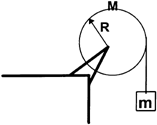BOX 7.3
Qualitative Strategies Written by
Students
Students enrolled in an introductory physics course were asked to write
a strategy for an exam problem
Exam Problem:
 A disk of mass, M = 2 kg, and radius, R = 0.4 m, has string wound around
it and is free to rotate about an axle through its center. A block of
mass, M = 1 kg, is attached to the end of the string, and the system is
released from rest with no slack in the string. What is the speed of
the block after it has fallen a distance, d = 0.5 m. Don't forget to
provide both a strategy and a solution.
A disk of mass, M = 2 kg, and radius, R = 0.4 m, has string wound around
it and is free to rotate about an axle through its center. A block of
mass, M = 1 kg, is attached to the end of the string, and the system is
released from rest with no slack in the string. What is the speed of
the block after it has fallen a distance, d = 0.5 m. Don't forget to
provide both a strategy and a solution.
Strategy 1: Use the conservation of energy since the only
nonconservative force in the system is the tension in the rope attached
to the mass M and wound around the disk (assuming there is no friction
between the axle and the disk, and the mass M and the air), and the work
done by the tension to the disk and the mass cancel each other out.
First, set up a coordinate system so the potential energy of the system
at the start can be determined. There will be no kinetic energy at the
start since it starts at rest. Therefore the potential energy is all
the initial energy. Now set the initial energy equal to the final
energy that is made up of the kinetic energy of the disk plus the mass M
and any potential energy left in the system with respect to the chosen
coordinate system.
Strategy 2: I would use conservation of mechanical energy to
solve this problem. The mass M has some potential energy while it is
hanging there. When the block starts to accelerate downward the
potential energy is transformed into rotational kinetic energy of the
disk and kinetic energy of the falling mass. Equating the initial and
final states and using the relationship between v and * the speed of M
can be found. Mechanical energy is conserved even with the
nonconservative tension force because the tension force is internal to
the system (pulley, mass, rope).
Strategy 3: In trying to find the speed of the block I would try
to find angular momentum kinetic energy, use gravity. I would also use
rotational kinematics and moment of inertia around the center of mass
for the disk.
Strategy 4: There will be a torque about the center of mass due
to the weight of the block, M. The force pulling downward is mg. The
moment of inertia about the axle is
1/2 MR2. The moment
of inertia multiplied by the angular acceleration. By plugging these
values into a kinematic expression, the angular speed can be calculated.
Then, the angular speed times the radius gives you the velocity of the
block.
The first two
strategies display an excellent understanding of the principles,
justification, and procedures that could be used to solve the problem
(the what, why, and how for solving the problem). The last two
strategies are largely a shopping list of physics terms or equations
that were covered in the course, but the students are not able to
articulate why or how they apply to the problem under consideration.
Having students write
strategies (after modeling strategy writing for them and providing
suitable scaffolding to ensure progress) provides an excellent formative
assessment tool for monitoring whether or not students are making the
appropriate links between problem contexts, and the principles and
procedures that could be applied to solve them (see Leonard et al.,
1996).